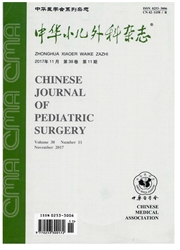

 中文摘要:
中文摘要:
目的研究胆道闭锁(biliary atresia,BA)患儿肝组织中HMGB1、RAGE及NF-IcB的表达,探究其与胆道闭锁发生关系。方法利用免疫组化(SABC法),Westenblot及RT-PCR技术对9例BA患儿和6例胆总管囊肿(congenital biliary dilatation.CBD)患儿的肝脏组织标本进行对比研究。结果免疫组化结果显示BA组和CBD组患儿肝组织细胞及肝内胆管上皮细胞中HMGBl的表达分别为0.58±0.05和0.19±0.03、RAGE的表达分别为0.45±0.06和0.11±0.03、NF-κB的表达分别为0.49±0.06和0.12±0.03,BA组明显高于CBD组;Westenblot和RT-PCR的检测结果也是BA组明显高于CBD组。在BA组患儿肝组织中,HMGB1与RAGE蛋白表达强度呈正相关(r=0.7602,P〈0.05,OR=2.1172),RAGE与NF-κB蛋白表达强度亦呈正相关(r=0.7219,P〈0.05,OR=1.9082),而CBD组患儿其表达无相关性。结论BA患儿肝细胞及肝内胆管上皮细胞中HMGB1、RAGE及NF-xB的表达异常升高,可能在BA发病中有重要作用。
 英文摘要:
英文摘要:
Objective To study the expressions of HMGB1, RAGE, NFmB in liver tissues of the patients with biliary atresia (BA). Methods Liver specimens were obtained intraoperatively from 11 patients with BA and 6 with congenital choledochal cyst (CBD). The protein and mRNA expres- sions of HMGBI, RAGE, NF-κB were detected by immunohistochemical staining, western blotting, and RT-PCR. Results The expressions of HMGB1, RAGE, NF-κB in hepatic cells and bile ducts epi- thelial cells from BA patients were significantly higher than those from CBD patients. In patients with BA, the increased expression of RAGE was positively correlated with HMGB1 expression (r = 0. 7602, P〈0. 05, OR = 2. 1172). And the increased expression of NF-κB was positively correlated with RAGE expression (r= 0. 7219, P〈0. 05, OR = 1. 9082). However, in patients with CBD, nei ther HMGB1 nor NF-κB was correlated with RAGE. Conclusions Abnormal expressions of HMGB1, RAGE, NF-κB are found in livers of BA patients, which may play a role in the development of BA.
 同期刊论文项目
同期刊论文项目
 同项目期刊论文
同项目期刊论文
 期刊信息
期刊信息
